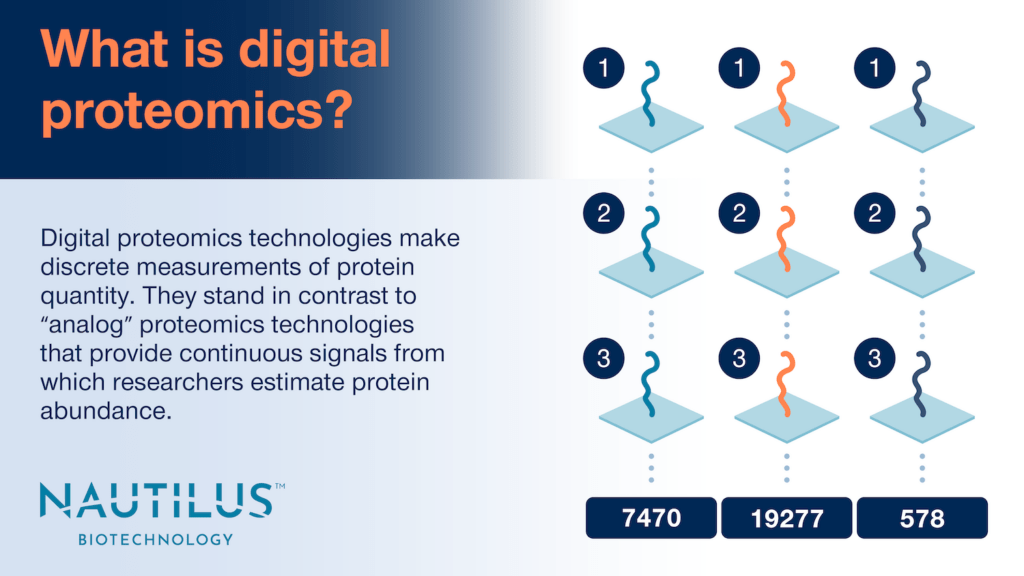
Digital proteomics technologies make discrete measurements of single protein molecules. They stand in contrast to “analog” proteomics technologies that provide continuous signals from which researchers estimate protein abundance.
“Digital” takes on a variety of colloquial meanings. For our purposes, a digital technology is one that provides discrete readouts that take on a finite number of values. So, digital proteomics technologies provide granular data as opposed to continuous data. A good analogy is a digital versus an analog thermometer. A digital thermometer might output 300 possible discrete temperature measurements (0°, 1°, 2°…) as opposed to a continuous range of heights climbed by mercury in an analog, mercury thermometer.
For many applications, a digital readout is easier to understand and interpret because its discrete units only fall into a specified range of values that are generally easier to compare across samples. To understand why a digital readout is easier to understand, consider an analogy where you’re telling a friend what heating or cooling level you prefer in a car. If the air conditioning dial has discrete, digital settings (1, 2, 3, 4 ,5), it’s easy to relay your preference. You just say what number you want. If the thermostat dial is continuous, it may be harder to describe your preference.
Analog proteomics
Many current proteomic measurements are not digital, at least not in terms of their protein abundance outputs. These technologies generally provide abundance measurements that fall across a continuous range and are often normalized to a control.
For example, when researchers use mass spectrometers to measure protein abundance, they often normalize peptide peak heights or areas to those from samples with known concentrations of the peptide or those from a control sample. The peptide peaks generated by the mass spectrometer have heights that fall in a continuous range, and it is not clear how these peaks relate to discrete units of proteins. Molar concentrations can be extrapolated from standard curves, but these are continuous estimates and not digital counts of proteins.
The NautilusTM Proteome Analysis Platform is designed to provide digital counts of single protein molecules
The Nautilus Proteome Analysis Platform is designed to conduct digital proteomics by isolating intact single protein molecules, attaching them to discrete landing pads on 10-billion landing pad arrays, and iteratively probing each individual protein molecule in a massively parallel way using multi-affinity probes. Patterns of probe binding are converted into protein identity by our machine learning algorithm and each protein at each landing pad is revealed to have a discrete identity (1 of the roughly 20,000 human proteins).
To quantify proteins, the platform counts the number of times each protein species is identified. This is digital counting because quantities are not on a continuum but are discrete protein counts— true digital proteomics.
Benefits of digital proteomics
There are many benefits to conducting digital proteomics on the Nautilus Platform. These include:
- Precision – A technology that performs digital protein counting can provide measurements that are more precise. There will not be fuzzy estimates from normalization of continuous signals.
- Easy-to-understand proteomics data – Counts of single protein molecules are easier to work with and understand than values extrapolated from comparison to a calibration curve or a control. This also enables easier integration with other digital omics techniques.
- Robust insight generation – The above benefits culminate into this much broader benefit. Protein activity is highly dependent on protein quantity. Small changes to low abundance proteins like transcription factors or cytokines can have large impacts on cell function, but these changes will be difficult to observe without digital protein counting. Similarly, high abundance proteins often form parts of protein complexes with precise stoichiometries. A digital proteomics technology can detect critical changes to these stoichiometries. Such changes may be highly impactful but might fly under the radar with traditional technologies that provide fuzzy estimates of protein abundance.
The future of digital proteomics
Overall, digital protein counting and digital proteomics make the proteome much easier to measure and compare between samples. Digital proteomics technologies thereby open the proteome to more researchers for more fruitful avenues of discovery that may revolutionize basic biology, healthcare, and much more.
MORE ARTICLES


